|
|
|
Sort Order |
|
|
|
Items / Page
|
|
|
|
|
|
|
| Srl | Item |
| 1 |
ID:
104899


|
|
|
|
|
| Publication |
2011.
|
| Summary/Abstract |
Agriculture has an important role in every country's development. Particularly, the contribution of agriculture to development and competitiveness is increasing with agricultural productivity growth. Productivity, in turn, is closely associated with direct and indirect use of energy as an input. Therefore, the importance of energy in agriculture cannot be denied as one of the basic inputs to the economic growth process. Following the importance of energy in Turkish agriculture, this study aims to estimate the long- and short-run relationship of energy consumption, agricultural GDP, and energy prices via co-integration and error correction (ECM) analysis. Annual data from 1970 to 2008 for diesel and electricity consumptions are utilized to estimate long-run and short-run elasticities. According to ECM analysis, for the diesel demand model, the long-run income and price elasticities were calculated as 1.47 and -0.38, respectively. For the electricity demand model, income and price elasticities were calculated at 0.19 and -0.72, respectively, in the long run. Briefly, in Turkey, support for energy use in agriculture should be continued in order to ensure sustainability in agriculture, increase competitiveness in international markets, and balance farmers' income.
|
|
|
|
|
|
|
|
|
|
|
|
|
|
|
|
| 2 |
ID:
115681


|
|
|
|
|
| Publication |
2012.
|
| Summary/Abstract |
We report new experimental evidence of the household response to weekday differentials in peak and off-peak electricity prices. The data come from Auckland, New Zealand, where peak residential electricity consumption occurs in winter for heating. Peak/off-peak price differentials ranged over four randomly selected groups from 1.0 to 3.5. On average, there was no response except in winter. In winter, participant households reduced electricity consumption by at least 10%, took advantage of lower off-peak prices but did not respond to the peak price differentials. Response varied with house and household size, time spent away from home, and whether water was heated with electricity.
|
|
|
|
|
|
|
|
|
|
|
|
|
|
|
|
| 3 |
ID:
179683
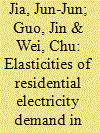

|
|
|
|
|
| Summary/Abstract |
China has implemented the residential increasing-block electricity pricing (IBEP) policy since the second half of 2012, which is considered the most effective economic instrument in improving residential energy efficiency. Price and income elasticity are two fundamental parameters to guide both scholars and policy-makers in assessing whether and to what extend Chinese households respond to the policy. However, it presents the challenge of simultaneous determination of marginal price and electricity consumption; further, it is less examined from an empirical perspective due to the absence of micro-level data. To fill this gap, this study estimates price and income elasticity by establishing two instrumental variables, based on a unique dataset from the Chinese Residential Energy Consumption Survey 2014. Results show that the residential demand for electricity is price inelastic and that electricity is an essential commodity for households in the short run. It also shows great urban-rural disparity and regional heterogeneity of household electricity consumption behavior regarding short-run income elasticity. The estimated parameters of short-run price and income elasticities provide a valuable reference for policy-making regarding both a nationwide uniform and a differential regional perspective.
|
|
|
|
|
|
|
|
|
|
|
|
|
|
|
|
| 4 |
ID:
125526
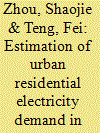

|
|
|
|
|
| Publication |
2013.
|
| Summary/Abstract |
This paper uses annual urban household survey data of Sichuan Province from 2007 to 2009 to estimate the income and price elasticities of residential electricity demand, along with the effects of lifestyle-related variables. The empirical results show that in the urban area of Sichuan province, the residential electricity demand is price- and income-inelastic, with price and income elasticities ranging from -0.35 to -0.50 and from 0.14 to 0.33, respectively. Such lifestyle-related variables as demographic variables, dwelling size and holdings of home appliances, are also important determinants of residential electricity demand, especially the latter. These results are robust to a variety of sensitivity tests. The research findings imply that urban residential electricity demand continues to increase with the growth of income. The empirical results have important policy implications for the Multistep Electricity Price, which been adopted in some cities and is expected to be promoted nationwide through the installation of energy-efficient home appliances.
|
|
|
|
|
|
|
|
|
|
|
|
|
|
|
|
| 5 |
ID:
162282


|
|
|
|
|
| Summary/Abstract |
As a pillar industry in China, the iron & steel sector have under through rapid growth and technical progress for decades. However, energy polices aiming at energy savings may not be as good as expected due to the existence of rebound effects. The motivation of the paper is to analysis the nexus between technical progress and energy rebound effects. Based on a three-input trans-log cost function model, we first estimate the share equation and the corresponding price elasticity for each input factor. Then, the rebound effect in China's iron & steel industry over 1985–2015 is evaluated through decomposing the energy prices. Empirical results show that: (1) The price elasticities of input factors are negative; (2) Energy/capital and energy/labor show substitute relationships; (3) The average energy rebound effect in the ISI is as high as 73.88%; (4) The energy rebound effect shows a downward trend before the 11th Five-year period and then an upward trend after that. Therefore, policies proposals of lowering the rebound effect should be placed not only on technical progress, but also on energy price reform by reducing energy subsidies and thus accelerating energy price marketization, so as to promote energy substitution, reduce energy rebound effect and produce further economic and environmental benefits.
|
|
|
|
|
|
|
|
|
|
|
|
|
|
|
|
| 6 |
ID:
175899
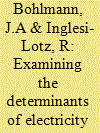

|
|
|
|
|
| Summary/Abstract |
For the period 1975–2016, this paper examines the determinants of the residential demand for electricity in South Africa including disposable income, electricity prices, food prices as well as the impact of the 2007/08 load-shedding wave and the 2008 electricity price restructuring. Given the high income inequality levels in South Africa, this relationship was investigated at aggregated and disaggregated income levels. Based on an Autoregressive Distributed Lag (ARDL) model, the empirical results indicate long-run cointegration between residential electricity consumption, gross national disposable income, electricity prices and food prices. Disposable income elasticities have a positive sign for the aggregate and all income groups, indicating that as income increases, South African households consume more electricity (normal good). As expected, price elasticities are negative and significant – for both the aggregated and disaggregated models – indicating that electricity prices do influence electricity demand for all South African households. The paper also examines the complementarity or substitutability of food and electricity. At both the aggregated and disaggregated income levels, the results showed that food and electricity are substitute goods for all South African households. However, as expected, the magnitude of this relationship is marginally different for each income group.
|
|
|
|
|
|
|
|
|
|
|
|
|
|
|
|
| 7 |
ID:
119153
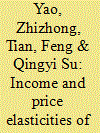

|
|
|
|
|
| Publication |
2013.
|
| Summary/Abstract |
The appearance of new product varieties and improvements in the quality of goods have both played key roles in the rapid growth of China's exports. However, these two important elements have not been formally integrated into the demand equations for China's exports. As we demonstrate in this paper, income elasticity will be underestimated if new varieties of goods and quality improvements are omitted in price index and quantity index calculations, which are necessary for estimating the export demand function. Moreover, the faster new product varieties enter export markets, the greater the underestimation will be. In this paper, we develop an export demand equation that takes into account new product varieties and improvements in quality, and then calculate the demand function for China's exports using the data from 1992 to 2006. According to our estimation, the short-term income elasticity of demand for China's exports is approximately 2.34, and the short-term price elasticity is approximately -0.65. Our estimation predicts an increase in China's export value in the case of an RMB appreciation or export rebate rates reduction in the short term, due to the low price elasticity of China's exports, whose absolute value is less than 1. Our findings are novel and could have significant policy implications.
|
|
|
|
|
|
|
|
|
|
|
|
|
|
|
|
| 8 |
ID:
109435


|
|
|
|
|
| Publication |
2011.
|
| Summary/Abstract |
Cointegration and vector error correction modeling approaches are widely used in electricity demand analysis. The study rigorously examines the determinants of electricity demand at aggregate and sectoral levels in Pakistan. In the backdrop of severe electricity shortages, our empirical findings give support to the existence of a stable long-run relationship among the variables and indicate that electricity demand is elastic in the long run to both income and price at aggregate level. At sectoral level, long-run income and price elasticity estimates follow this pattern except in agricultural sector, where electricity demand is found elastic to output but inelastic to electricity price. On the contrary, the coefficients for income and price are rather small and mostly insignificant in the short run. We employed temperature index, price of diesel oil and capital stock at aggregate and sectoral levels as exogenous variables. These variables account for most of the variations in electricity demand in the short run. It shows that mechanization of the economy significantly affect the electricity demand at macro level. Moreover, elastic electricity demand with respect to electricity price in most of the sectors implies that electricity price as a policy tool can be used for efficient use and conservation.
|
|
|
|
|
|
|
|
|
|
|
|
|
|
|
|
| 9 |
ID:
143377
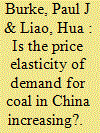

|
|
|
|
|
| Summary/Abstract |
China's dependence on coal is a major contributor to local and global environmental problems. In this paper we estimate the price elasticity of demand for coal in China using a panel of province-level data for 1998–2012. We find that provincial coal demand has become increasingly price elastic. As of 2012 we estimate that this elasticity was in the range − 0.3 to − 0.7 in point estimate terms when responses over two years are considered. The results imply that China's coal market is becoming more suited to price-based approaches to reducing emissions. The elimination of coal consumption subsidies could reduce national coal use and related emissions by around 2%.
|
|
|
|
|
|
|
|
|
|
|
|
|
|
|
|
| 10 |
ID:
166303


|
|
|
|
|
| Summary/Abstract |
The United States (US) Renewable Fuel Standard and California's Low Carbon Fuel Standard support the use of soy biodiesel and renewable diesel in the transport fuel supply for climate mitigation. However, linkages between the markets for soy oil and palm oil, which is associated with very high land use change emissions, could negatively affect the climate performance of soy-based biofuels. This study estimates the own and cross-price elasticities for the supply of soy and palm oils in the US using country-level data from 1992 to 2016 under rational expectations, through a seemingly unrelated regressions system of equations. We find a positive cross-price elasticity of palm oil import with respect to soy oil price and a positive reaction of supply of soy oil to increase in prices of palm oil. These results suggest that US biofuel policies may underestimate substitution between soy and palm oils and thus overestimate the climate benefits from soy-based biofuel.
|
|
|
|
|
|
|
|
|
|
|
|
|
|
|
|
| 11 |
ID:
150375
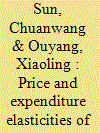

|
|
|
|
|
| Summary/Abstract |
Urbanization, one of the most obvious characteristics of economic growth in China, has an apparent “lock-in effect” on residential energy consumption pattern. It is expected that residential sector would become a major force that drives China's energy consumption after urbanization process. We estimate price and expenditure elasticities of residential energy demand using data from China's Residential Energy Consumption Survey (CRECS) that covers households at different income levels and from different regional and social groups. Empirical results from the Almost Ideal Demand System model are in accordance with the basic expectations: the demands for electricity, natural gas and transport fuels are inelastic in the residential sector due to the unreasonable pricing mechanism. We further investigate the sensitivities of different income groups to prices of the three types of energy. Policy simulations indicate that rationalizing energy pricing mechanism is an important guarantee for energy sustainable development during urbanization. Finally, we put forward suggestions on energy pricing reform in the residential sector based on characteristics of China's undergoing urbanization process and the current energy consumption situations.
|
|
|
|
|
|
|
|
|
|
|
|
|
|
|
|
| 12 |
ID:
171368
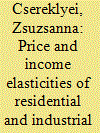

|
|
|
|
|
| Summary/Abstract |
This study examines the short- and long-run price and income elasticities of residential and industrial electricity demand in the European Union between 1996 and 2016. Instrumental variable models using the between estimator, as well as dynamic panel models are employed to present robust estimates, and to assess the impact of different methodologies on the reported elasticities. The long-run price elasticity of residential electricity consumption is estimated between −0.53 and −0.56. These elasticities are more inelastic than that of industrial electricity use, which is reported between −0.75 and −1.01. The choice of different econometric methodologies has only moderate impact on the estimates. While long-run residential income elasticity estimates are moderately inelastic and estimated around 0.61, industrial electricity use tends to be closely tied to income, with elasticities between 0.76 and 1.08. Electricity demand in all sectors is highly price and income inelastic in the short run. Additionally, population density, temperatures, and policy measures also influence sectoral electricity use. The above estimates can aid the design of European energy and environmental policy.
|
|
|
|
|
|
|
|
|
|
|
|
|
|
|
|
| 13 |
ID:
105790


|
|
|
|
|
| Publication |
2011.
|
| Summary/Abstract |
In this paper, the price elasticity of electricity demand, representing the sensitivity of customer demand to the price of electricity, has been estimated for South Australia. We first undertake a review of the scholarly literature regarding electricity price elasticity for different regions and systems. Then we perform an empirical evaluation of the historic South Australian price elasticity, focussing on the relationship between price and demand quantiles at each half-hour of the day.
This work attempts to determine whether there is any variation in price sensitivity with the time of day or quantile, and to estimate the form of any relationships that might exist in South Australia.
|
|
|
|
|
|
|
|
|
|
|
|
|
|
|
|
| 14 |
ID:
092576


|
|
|
|
|
| Publication |
2009.
|
| Summary/Abstract |
In the assessment and review of regulatory reforms in the electric power market, price elasticity is one of the most important parameters that characterize the market. However, price elasticity has seldom been estimated in Japan; instead, it has been assumed to be as small as 0.1 or 0 without proper examination of the empirical validity of such a priori assumptions. We estimated the regional power demand functions for nine regions, in order to quantify the elasticity, and found the short-run price elasticity to be 0.09-0.30 and the long-run price elasticity to be 0.12-0.56. Inter-regional comparison of our estimation results suggests that price elasticity in rural regions is larger than that in urban regions. Popular assumptions of small elasticity of 0.1, for example, could be suitable for examining Japan's aggregate power demand but not power demand functions that focus on respective regions. Furthermore, assumptions about smaller elasticity values such as 0.01 and 0 could not be supported statistically by this study.
|
|
|
|
|
|
|
|
|
|
|
|
|
|
|
|
| 15 |
ID:
168641
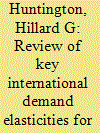

|
|
|
|
|
| Summary/Abstract |
This paper conducts a selective review of various estimates for energy demand responses focused specially upon lower-income industrializing economies rather than richer mature nations. It emphasizes recent trends from empirical studies that have been published after 2000. Emphasis is placed on the five major emerging or transitional economies in Brazil, China, India, Mexico and Russia, although other important nations like Chile and South Korea are also discussed when studies are available. The review focuses attention on the long-run responses to changes in prices and income after capital stock turnover has been completed. The terminology often refers to elasticities, or the percentage change in energy use divided by the percentage change in price (or income), holding constant all other factors that could influence energy-use decisions. Estimates cover petroleum products, natural gas and electricity, although the available studies often ignore coal. They also include the economy-wide impacts (real GDP) to price changes. Most studies have focused upon household and transportation use of liquid fuels; many fewer studies have investigated fuels used by industry or commerce or for electric generation. Based upon the available estimates, price and income elasticities for liquid fuels are generally less than one (unity) for many countries and sectors, except for the long-run income effect for transportation purposes, which can range widely by country between 0.24 and 1.75 while averaging 0.94 for all countries.
|
|
|
|
|
|
|
|
|
|
|
|
|
|
|
|
| 16 |
ID:
176649


|
|
|
|
|
| Summary/Abstract |
Understanding the energy use and choice behaviors in urban China is essential to curb its energy consumption and air pollutant emissions. Current energy consumption estimates for urban households in China rarely account for the effects of building types on energy choice behavior, thus may lead to biased policy implications. In this paper, we estimate the determinants of household energy consumption for different energy choice scenarios through the Seemingly Unrelated Regression (SUR) model, using urban household data. The empirical results show that household use of various energy carriers is driven by household income, fuel price, demographics, building attributes and lifestyles. Results show building types have a significant effect on household energy consumption behaviors. Households living in old houses have less access to clean energy, such as piped gas. Income and price elasticities of energy consumption vary with energy type in each scenario, and there exist certain substitution effects among different types of energy carriers. In particular, inter-fuel substitute elasticities between coal and clean energy are asymmetric. Our study highlights the significance of city planning and infrastructure expansion policies and also offers a better basis for coordinating and designing energy policies in urban China and other developing countries.
|
|
|
|
|
|
|
|
|
|
|
|
|
|
|
|
|
|
|
|
|